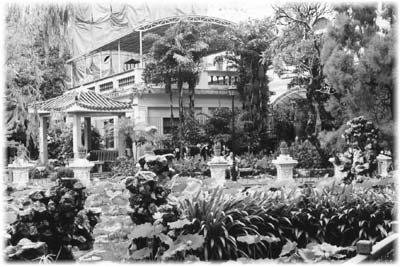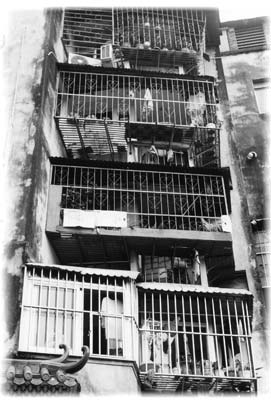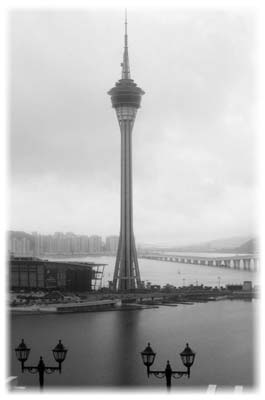Macau — where cultures merge and the past mingles with the present
by Roger Canfield, Contributing Editor
Seeing Macau’s more than 400-year-old European-style buildings is time travel accented by a 13-hour flight from Los Angeles. I saw newly restored evidence of Macau’s Portuguese and Chinese pasts: gothic, baroque, neoclassical and Chinese architecture plus modern and ancient art and exquisite exhibitions in many museums. Preserved are architectural landmarks of Christian missionaries, and Portuguese cuisine survives splendidly.
This old Macau sits amidst billions of dollars in modern 5-star hotel-casinos, bridges and roads. Modern Macau offers a Formula 3 Grand Prix, horse racing, dog racing and bungee jumping off Macau Tower.
All coexist within a compact, easily accessible (by foot or taxi) 13 square miles, including the Macau Peninsula and two islands, Taipa and Colôane.
Hospitality plus
After traveling 7,500 miles by plane, train and TurboJET (ferry from Hong Kong), I met my tour guide, a Portuguese-Indian named Alorino Noruega. For 22 years he has been a guide for the Macau Government Tourist Office (fax 853 510104 or visit www.macautourism.gov.mo).
Alorino promptly delivered me to The Landmark Hotel, a 5-star traveler’s haven.
After an invigorating shower, I was chauffeured with my group of journalists to lunch at 0 Porto Interior Restaurant (Rua do Almirante Sergio 259B; phone 853 967770), where jet lag fatigue melted away in good food, wine and companionship.
We asked Alorino to order for all of us, which turned out to be the smartest decision of the trip. I had tastes of cod potato cakes, nicely seasoned Portuguese sausage, clam chowder in a bread bowl, giant garlic prawns, and lightly curried pork and potatoes, plus I enjoyed a good Portuguese red wine. Thereafter, Alorino picked the best of every menu.
Several restaurants later I asked, “Where do you find bad food in Macau?”
“In 5-star restaurants!” Alorino replied.
Other fine restaurants included Restaurante Litoral (Rua do Almirante Sergio, 261A; phone 853 967878) and, on Taipa Island, O ’Manuel Cozinha Portuguesa (R. Fernao Mendes Pinto, No. 90 R/C; phone 853-827571).
Religious sites
Off misty cobblestoned streets in the rainy typhoon season of June we found the A-Ma Temple. A-Ma is the goddess who protects seafarers from the typhoon-plagued South China Sea. Chinese and Portuguese sailors alike have visited the temple, from ancient times to modern. Every day, observant Chinese burn incense offerings at the temple.
The ruins of an old Jesuit church, St. Paul’s Cathedral, is a massive stone façade of a cathedral burned down four times in two centuries. The last burning, in 1835 during a typhoon, is seen as a miracle since the fire on a hill led sailors and others to safety. The shell is propped up from behind by steel, like a permanent Hollywood set. St. Paul’s remaining statues, portals and engravings are among the greatest monuments to Christianity in Asia.
It was an easy walk down 60-some steps to Senado Square, Macau’s central plaza, tiled with wave-patterned cobblestones. Nearby is St. Dominic’s Church, first built by Dominican friars in the 1590s. The cream-and-white church houses an image of Our Lady of Fatima, celebrated annually.
Museum visits
The Grand Prix Museum (Rua Luis Gonzaga Gomes, 431; phone 853 7984108) celebrates 52 years of Formula 3 championship races. The museum displays the first winner, a Triumph 2, and other historic vehicles. The entry fee is 10 patacas ($1.25) for adults.
An exhibit at the Wine Museum (Rua Luis Gonzaga Gomes, 431; phone 853 7984188) revealed the Chinese and Portuguese arts of wine making. This Californian did not travel 7,500 miles to sip foreign wine, but after tasting a white, a red and a port I warmed to the place, a respite from the bad June weather. Tickets cost five patacas for adults, or MOP15 including wine tasting.
Lunch at the Plaza Restaurant (2 Andar, Edif. Xin Rua de Nagasaki; phone 853 706623), a massive yet elegant space, included dim sum and a wide selection of Chinese dishes served at intimate tables by waiters in white coats.
The dim sum was absolutely not Americanized Chinese food, which I find heavy on fat, salt and monosodium glutamate. Indeed, at no time in Macau did I miss the acid reflux pills I had left behind in California.
Our menu featured thin noodles with shredded chicken, cooked vegetables, steamed dumplings stuffed with shrimp and then pork, red bean soup with tapioca, and a deliciously seasoned rice which I devoured. (Later I was told one never finishes the last rice dish — it suggests that your host has failed to feed you well.) This feast cost about $12, and no one went away hungry.
We then rode to the Macau Maritime Museum (Largo do Pagode da Barra, 1; phone 853 595481), located at the site of the first Portuguese landing in 1515. The museum exhibited scale models of many ships, from trading junks to pirate ships. Collections of navigational instruments celebrated mankind’s greatest navigators: the Portuguese discoverers.
Also displayed were two boats used by Vietnamese people escaping the Communist takeover of Vietnam after 1975. One was of a large converted basket.
Tickets cost MOP10 for adults, Monday through Saturday, or MOP5 on Sunday.
The Macau Government Tourist Office offers a 5-day pass allowing entry to six air-conditioned, clean museums — the Grand Prix Museum, the Wine Museum, the Museum of Macau, the Maritime Museum, the Lin Zexu Museum and the Macau Museum of Art — for MOP25 ($3) for adults. Most museums offer free entry for seniors (over 65).
More Macau sights
I visited Lou Lim Ieoc Garden, an eclectic landscape of European and Chinese plants including miniature landscapes, steps, lotus ponds, pavilions, pathways and sculptures — all accenting a columned 19th-century mansion. In contrast, on a nearby hillside we saw the more modest tenements of some current residents of Macau.
The Macau Cultural Center includes the Macau Museum of Art (Av. Xian Xing Hai; phone 853 7919814 or visit www.artmuseum.gov.mo), displaying Macanese and Chinese paintings and sculptures. I am unfamiliar with stylized Chinese art, so I particularly enjoyed the mirthful sculptures of Joan Miró and the “Fantasy of Cote d’Azur,” an exhibit of 20th-century French art, that were temporarily on display. Tickets cost MOP5 for adults; admission is free on Sundays.
The Handover Gifts Museum of Macau (Av. Xian Xing Hai) massively celebrates the handover of Macau to China. It displays very elegant, meticulously handcrafted, sculptured gifts presented to the Macau Special Administrative Region by China’s regions. The gifts “symbolize the thriving and prosperous future of the motherland.”
The Pousada de São Tiago (Avenida da Republica; phone 853 378111 or e-mail reservations@saotiago. com.mo), a fort built in the 17th century and now an inn, retains its original stone and even evidence of water leaks in the stone archways and walls.
Macau Tower (Largo da Torre de Macau; visit www.macautower.com.mo), with its landfill developments and manmade lakes, is the symbol of modern Macau. I toured the observation deck, nervously looking out and down through seemingly thin Plexiglas.
The tower lies within the Cotai strip, where frenetic building is proceeding on major new casinos and on a massive new family theme park containing a manmade volcano, family rides, game booths, a wharf, restaurants, port and city models and a private yacht marina.
After joining thousands rushing through a barrier gate and waiting a long time at Chinese Immigration, I spent half a day up the peninsula in Zhu Hai, a Special Economic Zone of the People’s Republic of China. Down a wide stairway was an underground shopping center tight with hundreds of stalls offering every imaginable product, many bearing Western brand names and labels — counterfeit central.
While a visa is not required for Macau or Hong Kong, one is needed for visiting Zhu Hai, and it requires at least two days’ notice.
Getting there
Generally, October to November is the best time to visit Macau, with sunny days and lower humidity. The worst is May to September, when the temperature averages 80°-85°F, with very high humidity and drizzling rain, and typhoons may occur.
I flew from Los Angeles to Hong Kong aboard internationally acclaimed Cathay Pacific (phone 800/848-5008 or visit www.cathaypacific.com). From Hong Kong to Macau I took a fast train (costing $5 and running every 15 minutes) to the TurboJET ferry (www.turbojet.com.hk) to Macau ($17.50 and departing every half hour).
Public transport in Macau was cheap. A taxi cost around $4 within Macau or $15 from Macau to Colôane Island.
Staying there
I stayed at the Landmark Hotel (555 Avenida da Amizade; phone 853 781781 or visit www.landmarkhotel.com.mo), an air-conditioned respite, particularly in sweltering June. It offered rather spectacular digs for $140 to $310 per night, single, and had exercise rooms, an indoor pool, a business center and a casino located on a single floor.
It earned every star, except in accounting. Room numbers, names and bills were switched between two guests in our party.
Macau has eight other 5-star hotels and eleven 4-stars, in addition to hotels to fit every budget, including a student hostel at $25 per night. Rooms everywhere are rare and costly on Saturdays and holidays.
Roger Canfield’s trip was sponsored by the Macau Government Tourist Office.




